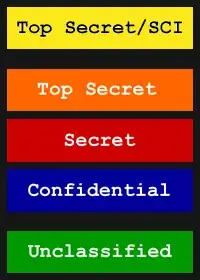Ok so after diving into this a bit, this is the best I can come up with. I do not work for the US government so I cant say anything with any level of confidence. However;
It seems that the color classification system is largely based on convenience. Since the whole point of having the classification marked on the pages of each document provides a simple method to check the clearance of the person with the requirements of the information. However, in the case where only text is used, it becomes difficult to assess at a glance whether someone is holding something they shouldn't. Hence, the color coding.
I started with a document referenced by the DoD Guide to Marking Classified Documents where on page 39 make reference to SF labels, this document makes a reference that points to DoD Directive 5200.1-R which states on page 59 Section C5.4.10:
C5.4.10.1.
If not marked otherwise, AIS storage media and other items covered by this section must be marked with the following labels:
C5.4.10.1.1. SF 706 - TOP SECRET
C5.4.10.1.2. SF 707 - SECRET
C5.4.10.1.3. SF 708 - CONFIDENTIAL
C5.4.10.1.4. SF 709 - CLASSIFIED
C5.4.10.1.5. SF 710 - UNCLASSIFIED
I also found a training document in the archives that shows pictures of these labels with the colors you describe on slide 46, also mentioning the SF codes of the labels. The slide also mentioned a reference in the line above the labels:
Within a classified environment, the following labels are authorized for use:
(Ref: 32 CFR 2001.80)
If we look at gpo.gov we find Document CFR 2001.80 which states on page 539, Subpart H, Section 9:
(9) SF 706, TOP SECRET Label: The SF 706 is used to identify and protect electronic media and other media that contain Top Secret information. The SF 706 is used instead of the SF 703 for media other than documents...
Looking up SF 703 on gpo.gov gives the full details of 703, no colors are mentioned but it does state an inventory number in subsection (e) along with the date of the document:
(e) The national stock number of the SF 703 is 7540-01-213-7901.
[50 FR 51826, Dec. 19, 1985]
Alas if we look for that on the government archives we see that we can't simply view the requirements for these or view examples as:
The following forms are available to U.S. government agencies, but cannot be placed on the website because of unique construction. It can be ordered by calling Global Supply customer assistance...
And if we look at the GSA for 703 specifically we see that authorization is required to get your hands on them, which makes sense given that they are meant to mark classified materials. However note the date also listed here:
Current Revision Date: 08/1985
We now have two sources that cite label SF 703 as having an inception date of around 1985. Lets take a look at the state of computers at that time. If we go to Wikipedia we can find a list of the history of color pallets for this time period (give or take). The pallets were very minimalistic.
What I think you are seeing here is the product of an old system being used to this day without having its definitions adapted. It's possible that SF 703 and its sister labels have a definite hex value, but that information would be held by the GSA, and i doubt they'll disclose it. But it seems to me that the reason you only see generic references to "orange" or "yellow" is because there was no ambiguity then about what that meant (think 16 color pallet of MS paint except from 1980's-1990's) red, orange, yellow, blue and green were easily recognizable on print media and very hard to mistake.
Long story short, there could be an exact value definition, but i doubt it. I think this is just a color coding scheme where the colors were picked a long time ago at a time where 16 color pallets were a thing and have been used ever since. Whatever "red" they used in 1985 is probably exactly the same one used today. It is not strictly in the definition of any classification system documents because it is meant to be an aid not a definition itself. Something to easily see "AH the document in his hand is yellow, but he has a red badge. Something is wrong." rather than a strictly defined principle as the actual word "SECRET" is.
Of course again, this is just based off what I saw when I dove into the subject. I could be wrong. Maybe there is some definition out there. But this is what I think. It was a fun little research though!
Now all I have to do is prepare my statement for when the NSA/FBI come to my door asking why I've been looking up and down the GPO, GSA, Gov Archives and Pentagon sites looking for Classification materials and Directives from the DoD...
